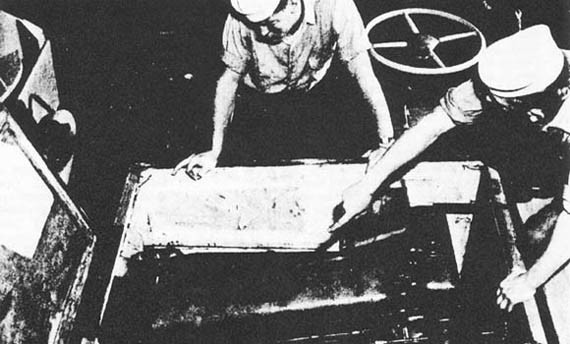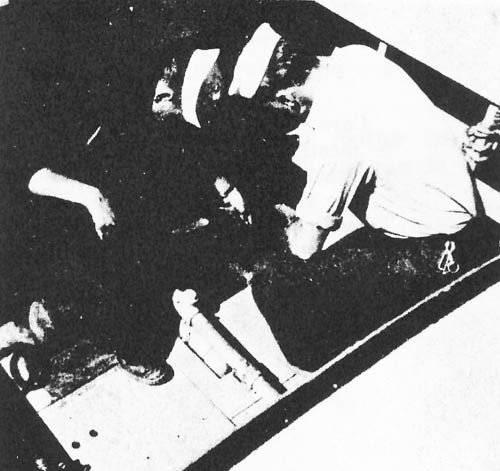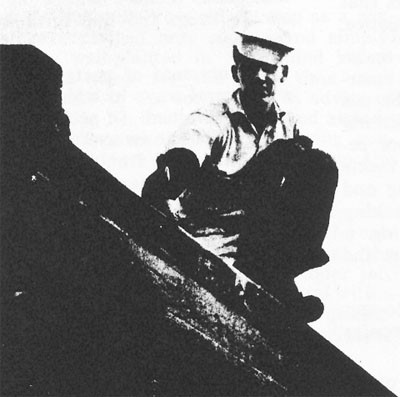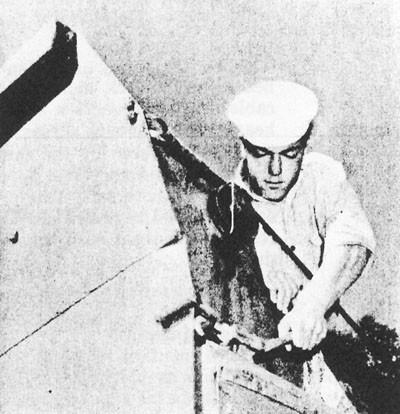
The Navy Department Library
Chapter V. Keep It Running!
* * * * *
Care and maintenance of the LCVP or LCM is mostly a matter of experience plus good judgment. The main rule to remember is given in the title of this chapter--keep it running! To which should be added "without harm to hull, engine, or gear." In other words, except in an emergency, the crew must know when to stop their boat, too. It certainly isn't wise, for example, to keep an engine running when it's overheated and getting hotter with every turn of the screw.
Remember then; boat care is mostly a matter of using good sense. You can develop "engine sense" and "boat sense" only through actual experience aboard your boat. Nevertheless, the suggestions here will help you to get off on the right foot on the path to seamanlike boat care.

--22--
The well-kept, taut LCVP or LCM is more than a pleasure to the eye. It is also a good form of life insurance. Your chances for a safe, successful run may be no better than the boat that carries you into an enemy-held shore. True, you do not need to worry about the enemy when in training, but if the right habits are formed in training you are likely to retain them at a time when smart boat handling and good seamanship are literally life-savers.
The daily boat and engine check. To the coxswain and engineer fall the responsibility for making the daily check on boat and engine. Each of these is required because it is essential to good performance. They are tasks to be done faithfully and thoroughly.
Insofar as the boat check is concerned, several matters are particularly deserving of attention. One of these is the condition of the bilge. Little or no bilge water is one good sign of a "healthy" boat with sound hull and tight packing. If water is sloshing around beneath the LCVP's floor boards, pump it out, then find the leak. Bad packing on the drive shaft or a loose boat plug (in the hull amid-ships near the automatic bilge pump) are two common sources of such water seepage.
Other items to be checked with especial care are the emergency tiller, lines, fenders, fire extinguishers, and mechanisms controlling the ramp and steering gear. Merely looking at equipment is not enough. When checking the tiller, for instance, be certain that it fits the rudder stock. Sometimes it does not, and is useless in an emergency! Is the anchor line and chain made fast to the anchor? Is there sufficient tension in the control cable running aft from the wheel to the rudder? A quick look is not enough to give you an answer to such questions.
As to the CO2 fire extinguishers, lift some that are freshly charged until you have a "feel" for a well-charged one. Then, if the one in your boat feels light, replace it with one that won't fail at the wrong moment.
In addition to these inspections, the coxswain is to check to see that all the gear listed in Chapter III is accounted for: life jackets, life rings, grapnel and line, winch crank, buckets, water breakers, and so forth.
Four items are the "lifeblood" of the marine diesel. If you are the motor machinist, give these top priority: (1) fuel, (2) lubricating oil, (3) the fresh and salt water cooling systems, and (4) the batteries. An ample supply of fuel and lubricating oil must be on hand at all times, for obvious reasons. The batteries rate care particularly because it is next to impossible to start the engine without them. Finally, a faulty cooling system is likely to mean either engine damage or complete breakdown.
A complete engine check, as carried out daily by the engineer includes these activities:

- Check sand traps. These sea water strainers must be clean.
- Check batteries. The water should be 3/8 of an inch above the plates.
- Check the fresh water supply. Fill the surge tank to within one inch of top. See that a full five-gallon can of fresh water is aboard.
- Check fuel supply. Port and starboard tanks should be full. Open the return valve on each tank, and open filter blade on primary filter and check fuel, oil, and water lines for leaks.
- Check the lubricating oil supply for quality and quantity. Be sure that both the main and reverse gear dip-sticks show a safe amount of oil. See that a five-gallon can of lubricating oil (S.A.E. 30) is available.
- Turn all grease cups down one-half turn on salt water, fresh water, and bilge pumps.
- Make sure that all belts are tight.
--23--
- In the bilges, check stuffing boxes on rudder post and propeller shaft. Also, see that forward and after bilge plugs are secure.
- Give scraper handle in primary fuel strainer two full turns.
- See that the ramp winch and winch cable are free and sufficiently coated with grease. Make sure that the cable shows no signs of fraying.
- Check steering apparatus. Cables should be taut and greased, the quadrant secure on the rudder post.
Care of the hull. The hulls of both the LCVP and LCM take a beating in every operation. Any man who has been in the surf is aware of this. Waves, sand, stones, collisions, each take a toll of these sturdy boats. They can take it, right enough, but the hulls will last much longer with reasonable care.

You are not expected to be a shipfitter, but you can keep your eye open for signs of trouble. The ramp hinges, for instance, may be in need of repair, or a steady accumulation of bilge water may indicate a leak. Perhaps the one thing that is most desirable in hull care, however, is observation of the old saying, "an ounce of prevention is worth a pound of cure." That is, try to avoid damage to begin with, then repairs will be fewer and less serious. Go alongside and dock skillfully. Hit that beach right. Get fenders out before they are needed, not after two or three jarring bumps against the pier.

Care of the ramp. The ramp is the distinctive feature of the "VP" and the tank lighter. It is one thing in their design that sets them apart from other boats. Without it they simply could not fulfill their purpose. It follows that the ramp must be kept in good condition.
Take a look at the landing boats lined up along the dock or parked on skids awaiting repairs. Nearly always their most battered section is the ramp. And no wonder. Jeeps, tanks, trucks, and miscellaneous kinds of cargo weigh plenty, and the ramp supports their weight frequently. (Those minor collisions with docks and other boats aren't exactly beauty treatments, either.)
Some of the cautions to be observed in ramp care include making sure: (1) that ramp dogs (hooks) are holding the ramp securely in position, (2) that cables are well greased and unfrayed, (3) that such cables are moving smoothly on the sheaves (or wheels) over which they are led, and (4) that the hinged steel cover for the window in the LCVP's ramp is secured. Since this window cover swings inward, and is very heavy, it could injure personnel in the cargo space if it came loose and fell downward.
The ramp winch, as an important part of the ramp control system, must be well-lubricated. When raising the ramp with the hand winch on the LCVP it is essential that the operator be certain that the safety pawl is operating. This pawl is a steel "finger" that fits into
--24--
the gear teeth and prevents the cable from unwinding once the operator has begun to reel it in.
When the ramp has been lowered to the beach, some slack is left in the supporting cables. This prevents a sudden strain when a heavy vehicle moves across the ramp or when the boat is moved by the surf. Before raising the ramp, sand and other foreign matter is removed with a broom. This prevents dirt from being pressed between the door and the gaskets or water-tight seals where the ramp meets the hull.
Care of gear. The equipment carried by the LCVP and LCM are kept in good condition through simple precautions which are too obvious to mention in detail. The batteries in flashlights should be fresh, and so forth. The coxswain makes sure that the correct allowance of gear is at hand and sees that it is kept up to snuff. The main principle to observe is that each item is ready for use at a moment's notice.
Minor repairs. No crew is expected to do an overhauling job on their boat, but small emergencies arise almost daily and require the use of the good old American knack of tinkering and repairing. Some of the typical minor repair jobs that you should be prepared to tackle are: replacement of loose or worn tubing and connections, fixing leaky water pumps, packing the drive shaft, cleaning filters, and fixing a steering cable that has worked loose from the drum directly below the steering wheel.
The coxswain's daily report should note any troubles that arise and any temporary repairs made during the day's operation.
Hints on boat care aboard transports. When your training at an amphibious base is completed your boat-care duties are far from finished. In fact, the closer you get to the particular D-day on which you make runs to shore under fire the more important boat care becomes. Aboard ship there are several precautions to be taken to insure that the LCVP's or tank lighters are ready for anything that comes along.
Check the tarpaulin with which the boat is covered. Small holes or tears will let the water in. Do not paint over moving parts. If you do they may "freeze" as the paint hardens. Even the heavy ramp may stick to the gaskets if paint is applied while it is pressed against the seals.
Rust must be removed as soon as possible. The longer one delays on this, the harder it is to do the job. Also, the gripes with which the boats are secured must be checked frequently. Finally, before moving from the transport into a beach action, all missing gear must be obtained.
The need for thorough preparation and for a well-kept boat which can be trusted to operate perfectly, simply cannot be overemphasized. In Normandy, during the invasion, German batteries of 88 millimeter guns covered the beach. These cannons were hard hitting and accurate, and it took just four minutes between the time their crews sighted a small boat on the beach and the time the shells began to fall. The small-boat boys had to get in, unload, and retract in just 240 seconds! After that they were working on "borrowed time." This illustration makes it quite obvious that you cannot afford to waste precious seconds with a ramp that sticks because some bungler slapped paint on the ramp and hull until they were frozen together.
Procurement of parts and materials. There are several ways in which parts and materials can be obtained. In action one of the handiest systems is known as "cannibalism." You strip what is needed from a wrecked LCVP or LCM and install the part in your boat. This saves a great deal of red tape and is highly suitable in an emergency--even though it isn't exactly according to Hoyle.
In most situations parts and materials are obtained in a more orthodox manner. Spare parts for diesel and gasoline engines are stored in a Spare Parts Distribution Center (SPDC). In the Pacific, for example, the SPDC is a sub-activity of the Naval Supply Depot, Pearl Harbor. Requisitions for needed material are signed by the Commanding Officer and forwarded to the appropriate SPDC.
As a boat crew member you may be called upon to supply information for requisitions. If an engine part is required, for example, these facts are needed: (1) engine manufacturer, type, and serial number of engine, (2) manufacturer's part number and description, (3) manufacturer's drawing number, if available, and (4) urgency of the request; priority one, part required to keep boat operating; priority two, part necessary for projected overhaul in an advanced area; and priority three, part to fill on-board allowance for general boat maintenance.
--26--
[End of Chapter 5]



